
Evaluating performance
Are you giving people what they want or what they need?
In the immortal words of Mick Jagger and Keith Richards, “You can’t always get what you want. But if you try sometimes, you just might find, you get what you need.” No one likes performance evaluations, but they are important tools. Giving people the feedback they need to hear helps them to grow and develop and ultimately become more productive. Performance evaluations tell them what they need to hear, not what they want to hear.
Feedback isn’t enough, formal evaluations are essential. Think of performance evaluations as an opportunity to communicate. A formal process allows everyone to engage in thoughtful communication, which avoids emotional reactions (sometimes occurring during spontaneous feedback) and provides a structure for giving good feedback.
Performance Evaluations are all about setting and meeting expectations. Performance evaluations are really about comparing someone’s performance against the expectations you have of them. When a 4-year-old ties their own shoes, you praise them; but when a 24-year-old ties their shoes, not so much praise. You have higher expectations of the 24-year-old.
The key is setting clear expectations. People’s expectations vary and even stated clearly, it’s easy to hear something different than what was meant. When you tell a 4-year-old to get ready to leave the house and you find them at the door without their shoes on, they get 1 point for being at the door, but a fail for no shoes. From their perspective, they have done everything they could to get ready – mission accomplished. Expectations were different.
Expectations also change over time, hopefully the 24-year-old will realize they need to put shoes on. But you might expect them to have the destination already in the GPS and the tickets pdf ready on their phone. Furthermore, sometimes the things that matter aren’t easy to quantify. Having someone accomplish a task with the right attitude is just as important as getting the task done. When the 4-year-old is dragged kicking and screaming from the house, the shoes victory is overshadowed.
Stating expectations upfront paves the path to success. Leaving someone to flounder, or to think they are on the right track when they aren’t, is setting them up to fail their next evaluation.
Write down expectations. Putting things in writing, even without a lot of detail, gives people a concrete starting point. It makes it easier to revisit expectations along the way. Writing things down helps track both performance and expectations then we get a clear view of what’s really going on. It also affords a non-emotionally tainted viewpoint.
Revisit expectations. Give feedback constantly, don’t wait 6 or 12 months. Giving feedback constantly and revisiting expectations is important so that small course changes can be made along the way before issues become insurmountable.
Who are you evaluating? You should be giving constant feedback and evaluation to both individuals and teams. Someone may perform well individually but might be disrupting the team dynamics causing not only friction but poor team performance. Clearly a situation that needs to be addressed.
Conversely, a team might be performing well but some individuals might not be pulling their weight which is demotivating and demoralizing to the team. Sometimes a team is performing well because some individuals are pulling the whole team along, this can burn out the individual and adversely affect the whole team.
Performance evaluations happen in the 4th dimension. Performance and expectations should be tracked over time, then we can have a much clearer understanding of the next steps. Below is a list of typical situations you may encounter, together with hints on how to deal with them.
Over-performance
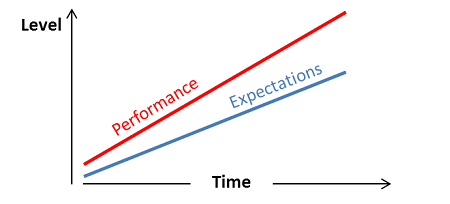
If someone is over-performing consistently, you need to up your expectations of them. Most typical way to handle this is through a promotion. Be careful though - that promotion can't be just a new title and a pay raise, it needs to come with more or new challenges. Otherwise you’ll find them eventually demotivated and moving on to a new role elsewhere.
Performance at expectations
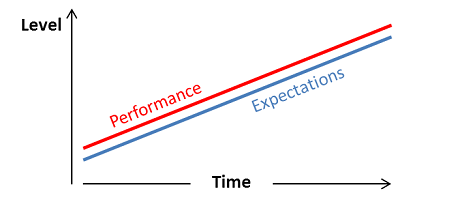
When someone's performance is consistently meeting expectations – great, make sure they stay on track. You may consider developing them further, eventually having them exceed expectations.
Under-performance
There are many flavors of under-performance. It's important to recognize and understand which situation you're dealing with, because the course of action depends on it.
Chronic under-performance
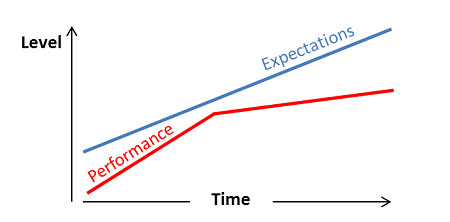
If there is constant under-performance, the person is not a good fit for the role. Time to cut bait, either find a better fitting role or let them go.
Sudden decrease
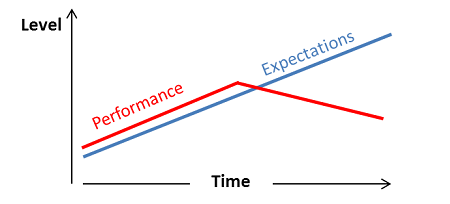
If someone's performance takes a sudden downturn, you need to establish the cause. If it’s organizational (new team, new boss, new tech), decide if this can be worked through or overcome. If it’s personal, decide if it’s temporary. If they can’t get back on track, you should let them go.
Stagnation

Sometimes people stagnate. They start well ahead, but don't ever get better. If this happens, it is important to recognize this before the delta between performance and expectation becomes too great to overcome. Developing the person may get them back on track, if not they should be let go.
Performance grows slower than expectations
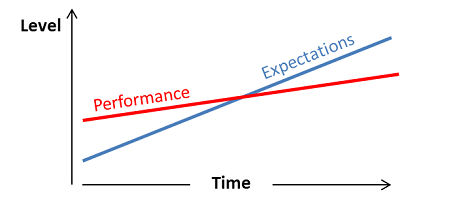
It can happen that someone's performance is increasing but is out paced by growing expectations. Here you need to decide if development (training or coaching) can bump performance, or if the role is simply too big for the individual and a new role can be found, or the role scaled back, or the person no longer fits and should be let go. Honest communication is needed to see if a solution can be reached.
Performance yo-yo

This is one of the most difficult situations. It happens when someone's performance is decreasing, they get feedback or even help, they improve, but then they revert back to poor performance. The trickiest part here is to recognize that this is happening. It's especially tricky if the person is also liked or if they have a specialized skill. You need to be very honest here, set a concrete deadline for performance improvement, and don't offer third or fourth chances. If a person can't maintain a steady performance, they are a drain on the team and should be let go.
Stagnant or decreasing expectations
You may have noticed that in all the above diagrams, the expectations are increasing over time. That's no accident. In a healthy organization, expectations gradually increase because each successful company should grow, innovate and challenge itself to improve.

If you are tracking decreasing expectations of someone, ask yourself if it’s a reflection of the company or if you are having an emotional reaction to someone and giving them some slack because you want to see them succeed. This is giving them what they want not what they need to grow and develop their skills.
Performance evaluations are a useful tool to have, develop and keep great people onboard. Setting clear expectations and revisiting them with constant feedback paves the way to success for everyone involved: the individual, the team, and the company.
Giving people what they need is much more beneficial than giving them what they want. Who knew the Rolling Stones were such team players.